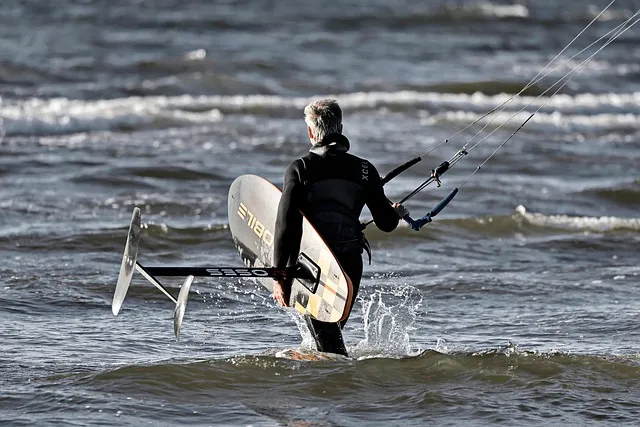For surfboard enthusiasts, choosing the right finish is a game-changer. This beginner’s guide dives into the world of epoxy and fiberglass finishes, offering a comprehensive understanding for those new to surfboard customization. Learn about the unique properties and benefits of epoxy, its advantages over fiberglass, and essential factors in making your choice. By the end, you’ll be equipped with knowledge to protect and maintain your surfboard finish, ensuring years of enjoyment on the waves.
Understanding Surfboard Finishes: A Beginner's Guide

For a surfboard for beginners, understanding the different finishes available is key. Surfboard finishes like epoxy and fiberglass are popular choices due to their durability and performance benefits. Epoxy finishes offer exceptional strength-to-weight ratio, making it ideal for enhancing maneuverability in the water. It’s known for its smooth surface that resists scratches and damage, ensuring your board looks new longer.
On the other hand, fiberglass finishes provide a more traditional look while still offering excellent durability. Fiberglass is flexible yet strong, which can help absorb impact and reduce the risk of breaks. For surfboard for beginners looking to save costs without compromising on quality, fiberglass finishes are an attractive option. These finishes also come in various colors, allowing you to personalize your board according to your taste.
What is Epoxy? Properties and Benefits for Surfboards

Epoxy is a highly versatile and durable material that has found its way into various industries, including the world of surfing. For surfboards, epoxy serves as both the resin and hardener in a composite construction process. This powerful adhesive binds together fiberglass sheets to create a lightweight yet incredibly strong shell for the board. The result is a surfboard that offers exceptional performance and longevity, making it an ideal choice for surfers, especially those just starting their journey in the sport.
In the context of a surfboard for beginners, epoxy’s benefits are numerous. It provides excellent buoyancy, ensuring the board floats well, which is crucial for confidence-building. The rigid structure created by epoxy reduces the risk of damage during falls and rough waves, making it a more durable option compared to traditional materials. Moreover, its ability to create smooth curves and intricate designs allows manufacturers to craft boards tailored to specific surfing styles, catering to both novice and experienced riders’ needs.
Advantages of Using Epoxy Finish on Your Surfboard

For surfboards, especially those designed for beginners, an epoxy finish offers numerous advantages over fiberglass alternatives. One of the key benefits is its superior durability and strength; epoxy coatings are known to resist impact damage better, ensuring your surfboard lasts longer even with heavy use from novice surfers. This longevity translates into cost-effectiveness, as you won’t need frequent repairs or replacements.
Additionally, epoxy finishes provide an excellent barrier against water absorption, helping to maintain the board’s structural integrity over time. This property is crucial for surfboards, which are constantly exposed to moisture and varying weather conditions. An epoxy-coated surfboard will also offer a smoother, more consistent surface, enhancing its performance in the water and contributing to a more enjoyable surfing experience for beginners.
Exploring Fiberglass: Types, Strengths, and Applications

Fiberglass is a versatile material that has gained immense popularity in various industries, including surfboard construction. When it comes to finishes, epoxy and fiberglass are often compared, but understanding the characteristics of fiberglass itself is essential. This durable composite material consists of fine glass fibers bound together with a resin matrix, typically polyester or epoxy. The strength-to-weight ratio of fiberglass makes it an excellent choice for surfboards designed for beginners and experienced surfers alike.
There are several types of fiberglass available, each with unique properties. For surfboards, E-glass is commonly used due to its balance of strength and cost-effectiveness. Its electrical resistance and smoothness make it ideal for creating smooth surfaces that can withstand the rigors of surfing. Fiberglass applications in surfboard design offer a range of benefits, from increased durability and reduced weight to enhanced performance in water. This makes fiberglass an attractive option for surfboard builders aiming to create high-quality boards suitable for beginners looking to catch their first waves.
Choosing Between Epoxy and Fiberglass: Factors to Consider

When it comes to finishing a surfboard, especially for beginners, the choice between epoxy and fiberglass is a significant decision. Both options have their unique advantages and considerations. For instance, epoxy offers superior durability, flexibility, and resistance to impacts, making it ideal for those who plan to use their surfboard aggressively in various conditions. It also provides a smoother finish, which can be advantageous for beginners learning to paddle and catch waves.
On the other hand, fiberglass is known for its cost-effectiveness and ease of application. It’s a more traditional material that has been used for decades in surfboard construction. Fiberglass finishes are generally lighter and can provide excellent strength, making them suitable for general surfing conditions. However, they may not offer the same level of impact resistance as epoxy, which could be a factor if you frequently encounter rocky shores or sharp objects in the water.
Application Process: Step-by-Step Guide for Beginners

Creating a stunning finish on your surfboard, whether it’s a fiberglass or epoxy project, is an art that every beginner should master. Here’s a simplified guide to help you navigate the application process:
1. Prepare Your Surfboard: Start by cleaning and sanding your surfboard to ensure a smooth surface. Remove any debris or old finishes with a fine-grit sandpaper. This step is crucial for a seamless application.
2. Choose Your Finish: For a fiberglass finish, mix the resin and hardener according to the manufacturer’s instructions. Apply an even coat using a roller or brush, making sure to cover all areas evenly. With epoxy, ensure your working space is well-ventilated, then carefully pour and spread the liquid resin with a dedicated tool for a smooth, bubble-free application.
3. Layering Technique: For both options, layering is key. Apply multiple thin coats, allowing each layer to dry completely before adding another. This process ensures an even and durable finish. Let the first coat dry, then assess if you need additional layers based on the product’s instructions.
4. Tools and Safety: Use appropriate tools like brushes or rollers suitable for your chosen finish. Wear protective gear, including gloves and a mask, to avoid skin irritation or inhalation of chemicals.
5. Curing Process: After the final coat, allow the finish to cure fully. The time varies depending on the product; read the instructions carefully. Curing ensures the finish hardens, resulting in a durable and glossy surfboard ready for the water.
Maintenance and Longevity: Keeping Your Surfboard Finish Protected

